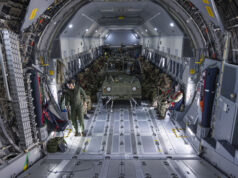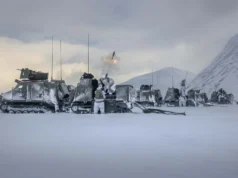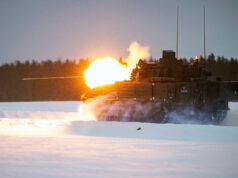Ministers have confirmed that recruitment challenges and shortages of skilled personnel are affecting a significant proportion of the British Army’s programme portfolio.
Responding to a question from Ben Obese-Jecty MP, Defence Minister Luke Pollard said “these resource challenges are impacting a significant portion of the Army Portfolio.”
The affected projects are outlined in the National Infrastructure and Service Transformation Authority (NISTA) Annual Report 2024–25, which provides confidence assessments for major defence programmes.
Pollard said the Army’s Programme and Portfolio Office “actively manages the prioritisation of programmes to ensure its workforce is allocated where it is most needed.” He added that the office offers “comprehensive Portfolio, Programme and Project Management training packages to develop current personnel and to attract talent into the team.”
The NISTA report, published on 11 August 2025, warned that the Army Programme Management Office faces difficulties recruiting staff with the required “skills and experience levels.” These shortages are affecting delivery confidence across parts of the Army’s modernisation portfolio, which includes major capability and digital transformation programmes.
Recruitment and workforce pressures are also evident in the wider force. In a separate question, Andrew Mitchell MP asked about the average time taken for a new recruit to progress from application to training entry.
Defence Minister Louise Sandher-Jones said that for the 12 months ending 1 July 2025, “the average time taken between application and untrained entry for UK/Irish Regular Other Ranks was 249 days.” Equivalent data for the Army Reserve, she said, “is not held centrally and will take some time to collate.”
The Ministry also released several caveats alongside the figures, noting that they exclude Gurkhas, Full-Time Reserve Service personnel, and non-UK applicants, and that the 249-day figure represents a median value rather than an average across all applicants.
Officials describe this “time of flight” between application and entry as a key performance indicator for recruitment efficiency. Data are derived from the Defence Recruitment System and matched with the Joint Personnel Administration database.
The long recruitment timeline and workforce gaps coincide with the Army’s efforts to deliver major transformation commitments under the Strategic Defence Review 2025, including new force structures, modernised command systems, and enhanced project delivery capacity.
The NISTA Annual Report 2024–25 is available here.














Decades of cuts, cuts and more cuts is the problem across the entire armed forces, mix that with a focus on targeted recruitment diversity rather than potential ability and this is what you end up with.
There is no pot of gold at the end of the rainbow, only the inevitable storm. 🌈⛈️
I remember talking to a doctor once, who said if I did an MRI of your whole body I could find loads of things wrong with you. So many organisations do the same thing these days, including the armed forces. We keep young adults at school until they are 18. Then they end up at university being over educated and in a lifetime of debt. Everything is so bureaucratic, you need 3 exams to get one GCSE. It’s absurd, especially when they still can’t find a job and end up with mental health issues. Less is more. That’s my take on it.
I remember at school when the class “Hardnuts” all went into the Army regardless of education, now you have to have degrees.
Education does not replace Intelect or natural ability, it just looks good on paper.
We are all “Sheeple” on our way to slaughter at the alter of mans ego.
This idea that all soldiers now have degree’s and that education matters isn’t the on the ground reality, your previous education is only counted in terms of what roles are open to you, and the vast majority do not require a degree. And your assessment grading is largely based on your performance at assessment, not on your CV.
It’s an Idea commonly believed though, maybe one of the reasons for these shortages ?
Obviously the decades of cuts and culling of experienced people is most likely the main cause, together with the oft mentioned Diversity drive and time taken to approve.
You don’t even need a degree to go to Sandhurst, you just need A levels. Within Units I don’t think I’ve ever been in a sub unit that has had more than 2-3 graduates that had achieved degrees pre-enlistment (discounting SNCO’s that had gained undergad or graduate qualifications in service). So if that’s a commonly believed thing it just goes to show how much misinformation gets spread.
“the oft mentioned diversity drive” is also (mostly, see my note at the end of this paragraph) load of bollocks, women, LGBT, and other minorities where until just a couple of years ago literally banned from serving, either completely or in certain roles. Thank god that has gone by the wayside, and as the saying goes “equality often feels like oppression to the privileged. Frankly if you see an army add and go “I don’t want to serve because the ad had black people and women in it,” then that’s probably a good thing. (Yes the RAF got in trouble for pausing recruitment of white men but a) that was because it was overwhelmingly white and male and wasn’t having a recruitment shortfall, and b) they got in trouble for it and it’s not regular practice. Again equality feeling like oppression to the privileged: Other groups have had complete bans on their service within living memory, white men where not banned from serving).
For time taken to approve see my comments below, people see the 249 number and assume that that is 249days with no communication and then suddenly a letter comes through the door saying “you start tomorrow.” That’s not the case.
Which groups have had complete bans on their service within living memory?
According to the data, 15 female officers joined Infantry regiments after graduating from the prestigious Royal Military Academy Sandhurst, but only 10, or 66%, then went onto successfully complete the infantry platoon commanders course to qualify them to lead infantry soldiers into battle.
The washout rate among female other ranks is worse, with 80 entering phase 1, or “boot camp”, level training but only 50 graduated, or 37%, to move into specialist infantry training. Then only 35 completed that to enable them to actually join their regiments, representing a 43% success rate.
For the Royal Marines the situation was far worse, with less than five women starting their basic training at the Commando Training Centre Lympstone. To date no female Royal Marines have graduated from Lympstone and no women have started officer training at Lympstone.
The data is pretty stark. Recruitment of women into the main close combat branches – the Royal Marines and Infantry of the British Army – has not generated a tidal wave of applicants rapidly progressing through training and into frontline units.
It’s a good analogy- MRI is impressive technology, but interpreting what it’s telling you requires some subjectivity. The trick is to combine the imagery with observed symptoms to determine if there really is a problem, rather than going looking for ‘problems’ that have no practical impact.
“Defence Minister Louise Sandher-Jones said that for the 12 months ending 1 July 2025, “the average time taken between application and untrained entry for UK/Irish Regular Other Ranks was 249 days.” Equivalent data for the Army Reserve, she said, “is not held centrally and will take some time to collate.””
249 days is a disgrace – I can well understand anyone loosing interest after that period of time.
The more telling part is the lack of collated data on reserves progression. Given all records are digital, I find this hard to believe. What are they trying to say that there is no central database – because it is on a database. Or are they saying the database was so badly created that the query cannot be run? Unlikely. Or that nobody wants to invest the few days of programmers time to create a UI that can extract that data because the data is embarrassing?
I’d favour the last option.
It really is a disgrace, but it would be useful to know what “untrained entry” meant, is that day 1 phase 1 or just the day selection is passed? Probably in the document I guess, might read it later who knows.
I have a small amount of experience with the reserves compared to regulars. My reserve application seemed much faster but very much organised on a wing and a prayer. Granted this was a fair while ago now.
This whole mad rush to Digital is biting us badly, just look at yesterdays outages, I even read aa article where It was suggested that all data be written down on paper as a safety backup.
We have come full circle in just a few decades and nothing is safe in a world riddled with cyber criminals.
Right then, I’ve used up all my Serious quota for this week, normal service will resume shortly.
Offline backups are a critical thing.
Encrypted SSD in a secure location is quite a good idea.
In our business I mirror the NAS arrays periodically and take the SSDs offsite and store them in a fireproof safe.
If you’ve made proper use of cloud availability zones then nothing short of a nuclear war should be able to threaten your online backups. Of course accessing them may be a different matter.
Hmme…..that didn’t work so well after the last lot of DNS upgrades that got fouled up…..
There is always sanity in having more backup using different technologies that don’t just involve cloud.
Yes, I use cloudiness for real time backups, NAS for onsite backups [was an issue when WFH was big, then physical media backups.
A hacker can’t hack and encrypt a disk in a safe!
“Heads in the Clouds”
we used Fax a lot and Photo Copied mostly, we had rooms full of paperwork (6 years legal records) which actually worked really well as the emails and digital systems often gave issues.
The first company I worked at had just started employing Computer Geeks to transform the whole business, I left after 5 years, It went bust 5 years later after the workforce shrank from 1000 to just a few dozen Computer based office Geeks.
Every glorious advert for jobs always shows smily people sat at screens in plush offices, never workers getting cold, wet and dirty.
UK economy is hell bent on being Services based, It has no room for Grunts but it’s the Grunts that do all the dirty work.
Digital is great if it is done thoroughly and properly.
The issue you describe is a poor digital transition. Probably because leadership didn’t understand what they were doing and were lead by the digital ‘experts’.
The “Leadership” embraced the Geeks, Ignored tradition and perfectly good working practices, mistakes happened more and more, so more Geeks and systems were employed and it all went Tit’s up big style.
Those who warned got ignored and dismissed as “Ludites” or just left.
A perfectly good business that had existed and thrived for nearly 200 years vanished in Ten.
I started my own at that time, never made the same glaring errors of judgement, retired recently, now I see history repeating itself in the trenches.
Technology is good when used appropriately.
My main concern is the AI bubble – not many companies actually a productivity increase from AI.
Mad rush? We have very different views of the MOD!
Remember when certain Warpac countries kept their copper wire comms? The “west” took the piss. Sometimes “old” ways are the best.
John, I am sure I read not so long ago that some commercial companies were going back to fax communications to eliminate the hacking threat.
It would make sense Graham. There have been too many recent mass hacking events for comfort.
Germany has spent 60 billion on digital ID and associated systems, with UK borrowing running at 20 billion a month there is no money for this folly. Its like a teenager who has maxed out his credit card buying a ten year old BMW on finance that they can’t afford to fix, it will require the engine management warning light covered with black tape!
“GROG”
I have a theory,
Back in the 1700’s the Royal Navy discovered that by watering down the Rum Ration, they could save money and get better work efficiency from the manpower.
This “GROG” process has been in use ever since but is now just Water, no actual Rum anymore.
I think we need to reverse this process imediately,
Drink Rum, save the Royal Navy.
Drink Beer, save the Army,
Drink Pimms, save the RAF.
“GROG” is bad.
The Army actually had/have a rum ration.
It just had to be ice age cold before it was issued.
Used to get gunfire on Christmas Day from the RSM. Most disgusting thing I have ever tasted!
It was so loaded, we could not tell if it was tea or coffee.
If yours tasted that bad – bromide!
Still do in some units.
It would be interesting to know what ‘skills shortages’ the APMO is suffering with. Presumably either appropriate technical specialists or capable project managers (or both). There is generally no shortage of such people- it’s merely a question of accepting that remuneration needs to reflect market rates.
Probably short of Grunts that just Fight.
Ian, as a graduate REME officer with PM skills I would have probably been a ‘shoe-in’ for a posting to APMO back in the day….but no-one would have paid me extra!
Quick one. Why not immediately raise the recruitment of Gurkhas? I know the numbers may not be much but a couple of additional battalions would go a long way AND, these guys serve for a minimum of 15 years.
Agree..
What technical skills will they bring?
Always worth remembering that Gurkha’s are mercenaries and there are very good reasons to have a cap on the number of mercenaries in your armed forces.
Sorry have to disagree with you on that point 100%. By strict legal definition under international law, the Gurkhas are not mercenaries because they form an integrated part of the army. Mercenaries by tradition work for private companies, which are in turn contracted. The Gurkhas also swear allegiance to the Crown and have done for over 200 years. This allegiance is extremely symbolic and treated with the utmost reverence by them. By your own analogy, the French Foreign Legion should also be regarded as mercs? By open admission, my family included extended have served in the Gurkhas for over 100 years so perhaps I am a little biased 🙂
They are foreign soldiers fighting for pay. They are mercenaries. Your personal bias is an issue here.
The only thing I would suggest is that you revisit the definition under international law – Article 47 of the 1977 Geneva Convention. I’ll even lay it out for you:
Article 47 of the 1977 Additional Protocol I to the Geneva Conventions provides an internationally recognised definition of a mercenary. This definition is crucial in distinguishing between legitimate combatants and mercenaries in armed conflicts.
The Article outlines six criteria that must all be met for an individual to be classified as a mercenary:
Special Recruitment: The person is specially recruited locally or abroad to fight in an armed conflict.
Direct Participation: The person actually takes a direct part in the hostilities.
Private Gain: The person is motivated to take part in the hostilities essentially by the desire for private gain.
Excessive Compensation: The person is promised or receives material compensation substantially in excess of that promised or paid to combatants of similar ranks and functions in the armed forces of the party to the conflict.
No Nationality or Residence: The person is neither a national of a party to the conflict nor a resident of a territory controlled by a party to the conflict.
Not a Member of Armed Forces: The person is not a member of the armed forces of a party to the conflict.
However, the Protocol also specifies exceptions to this definition. Notably, under Article 47(2)(e) and (f), individuals who are members of the armed forces of a party to the conflict are not considered mercenaries. This exemption applies to the Gurkhas serving in the British Army.
The Gurkhas are recruited under the Tripartite Agreement between the United Kingdom, Nepal, and India. They serve as regular soldiers in the British Army, forming part of the Brigade of Gurkhas. Their service is governed by this agreement, and they are integrated into the British military structure, performing the same duties as other units. As members of the British armed forces, they do not meet the criteria set out in Article 47 to be classified as mercenaries. Therefore, they are not subject to the restrictions and lack of protections that apply to mercenaries under international law.
In summary, while the Gurkhas may fulfill many of the criteria outlined in Article 47 for being considered mercenaries, the specific exemptions provided in the Protocol, particularly Articles 47(2)(e) and (f), categorically exclude them from this classification. Their status as regular members of the British Army ensures they are recognised as lawful combatants under international humanitarian law. No doubt you will still disagree with this which of course is your right. I’ll stop it here.
Cool story bro, but I wasn’t talking about international law was I? I made it clear I was talking about the colloquial definition which is a foreign national fighting for cash, and your quibbling about the definition under international law is ignoring the central point.
I am a passing traveller. But must take some small issue with your comment. Firstly, you made a statement, in no way did you qualify it as referring to the colloquial meaning. Post Doug’s reply you restated the statement and again did not qualify it. You then launched a bit of an ad hominem. Which I do not believe furthered your point.
A colloquial meaning of mercenary does mean a person fighting for cash. They need not necessarily be foreign. So, I would ask do you also apply your meaning to citizens of the Irish Republic, Fiji, African nations and West Indians in your meaning? If this is the case, thanks, I must update my CV. I can now add mercenary as an Australian who served in the British Army. Sounds a lot better, more rakish, more interesting.
“They are foreign soldiers fighting for pay. They are mercenaries. Your personal bias is an issue here.”
Seems like articles aren’t the only thing you don’t read Dinger. I made it pretty clear what I meant and anyone willing to engage honestly would see what my central point is.
And to your latter point: yes. They do. That is why there is a cap on commonwealth soldiers who are allowed to serve within the armed forces.
Dern, I don’t wish to appear deliberately obtuse. Your final point, “And to your latter point: yes. They do.” If, you are addressing the first part then they don’t. A Common meaning of mercenary according to several dictionaries; Cambridge – a soldier who fights for any country or group that pays them, Oxford – a soldier who will fight for any country or group that offers payment, Merriam-Webster – one that serves merely for wages.
If, however, you are addressing the second part, then thank you. It is evident you are no fan of the law, so I will be brief:
Commonwealth Citizens are not considered Foreign Nationals, and neither are their nations under British Law. British Nationality Act 1981, S37 and S50 -” “foreign country” means a country other than the United Kingdom, a British overseas territory, a country mentioned in Schedule 3 and the Republic of Ireland.” Schedule 3 lists the Commonwealth Therefore, by your colloquial meaning they cannot be mercenaries.
Actual foreigners/aliens (S50 again) allowed to serve are capped 1/50th of all regular forces. Army Act 1955, “21,(1) Subject to the provisions of the two next following subsections the number of aliens who at any one time are serving (whether as officers or soldiers) in the regular forces shall not exceed one fiftieth of the aggregate number at that time of those forces.” Therefore, Commonwealth Citizens are not restricted on grounds of being foreign or being seen as mercenaries. The cap on them is a movable feast based on requirement.
Despite your assertation my reply was an honest attempt to engage as I thought you were harsh on Doug, unnecessarily sarcastic and overly simplistic in replying in his attempt to clarify the position of Gurkhas. If it appeared otherwise, I apologise. I also replied below and offered a truce of sorts. We have a good swell this morning, so I am off to surf, which is Cool Bro, Hang Loose and peace to all.
Again reading comprehension is not your best suit.
You asked me if I count F&C troops as mercenaries under common definitions and I pointed out that I do count them.
You then went back into some shitty legal take that I already made clear is irrelevant to my argument.
Stick to surfing, it’s apparently the only thing you’re good at.
Dern is Army, so will know all that.
On expanding the Gurkhas, we have just created the KGA.
I don’t see them as Mercs myself, but as you describe. But, I agree with Dern that you don’t want too many foreign nationals serving in your Army, whatever way one describes them.
They’re seen as fine soldiers though and I’m glad we have them.
And I we recruit more, I’d prefer to see them in CS CSS roles, not Infantry Battalions.
I believe a tripartite agreement exists between UK/ Nepal/ India re Qty etc that can be recruted /employed. So it may not be that simple to say “Recruit More” I am told by troops that UK is first choice, followed by India then Nepal. The Nepalese have a vested interest as its some of thier best they are “exporting”
I don’t really see why the British Army could not given time increase the Gurkhas up to 5,000 or slightly over that figure..
Not far short already, I thought the Brigade of Gurkhas was around 4500?
This article seems to conflate two issues: shortage of SQEP (quite probably officers and WOs in the main, with technical, financial and PM skills) for the Army Programme Management Office (that must be a new thing, or an old Office renamed) and; the long time taken to process applicants from civvy street to the start of their Phase 1 training as a Private soldier….or have I mis-read this?
For the first issue – simply train people! Its not hard to do. Might also need to gap some posts elsewhere that are not so vital to move people into the APMO.
For the latter issue, the time taken is still an astonishing 249 days, but this is a median value. So some applications can take less time and some a lot longer. It was not long ago that we heard of many applicants waiting well over 365 days to be processed and to get on their Ph1 course.
It is now some time ago (at the Sep 2024 Labour Part Conference) that Healey said they were working to improve the speed of recruiting by the following
1.Scrapping 100 outdated policies that currently block people from joining the military.
2.Setting new targets for the Forces to reject or make a conditional offer to applicants within 10 days, and to give people a training start date within 30 days.
3.Introducing a direct recruitment route for cyber specialists, particularly targeting top gamers and coders.
Did the above actually happen?
It’ll be in committee somewhere. Especially if the services don’t like what he suggested…
Agreed, lack of SQEP, especially in the Cyber field, is not a Phase 1 issue. Phase 1 entry as a Private soldier at 18k per anum is not something that would be of interest to someone with a background in that field.
Re the wait, I think one thing that is missing is that part of the wait is for spaces on training courses to open. When you complete your initial assessment to join the Army your application gets ranked A through E (I think), and the higher your grade the more priority the army gives you for spaces in training. It was a long time ago, I think I got a B on my initial assessment, and was going for a trade that was in decent demand, which was about a 6 month wait. People with A’s or going for low demand jobs where getting into training a lot faster.
If you get a D, or are going for a degree that is in very high demand? Remember that it’s a median, not mean value, even when I joined I was warned that the waiting list for some roles (Dog Handler) was nearly 2 years, it doesn’t take a lot of those, or people with low scores being deferred for A’s and B’s before that number shoots north of 200.
Thanks Dern for the info from the sharp end!
249 days – did anyone ask the question why?
Still around 249 days to give someone a uniform – ridiculous. Recruitment times should be less than 100days
When the armed forces had their own recruitment offices many were processed and sent to unit in about 3 months.
True. Can’t remember my time from asking to arriving. But certainly less than 249daya
249 days Median, not Mean though.
As God is my witness, I am not picking a fight.
The article clearly states that, “the average time taken between application and untrained entry for UK/Irish Regular Other Ranks was 249 days.” The average being the mean. The median is the middle number when values are arranged in ascending order.
And further down:
“The Ministry also released several caveats alongside the figures, noting that they exclude Gurkhas, Full-Time Reserve Service personnel, and non-UK applicants, and that the 249-day figure represents a median value rather than an average across all applicants.”
Read the article maybe?
Did, perhaps we can split the difference on this one as both mean (average) and median were mentioned? And they can be the same value. Catch ya.
Nope:
“Depending on the context, the most representative statistic to be taken as the average might be another measure of central tendency, such as the mid-range, median, mode or geometric mean.”
Mean and Median are both types of average. The article specified that they where using Median Average, not Mean Average.
Hi Dern,
Nope:
“Depending on the context, the most representative statistic to be TAKEN AS THE AVERAGE MIGHT be another measure of central tendency, such as the mid-range, median, mode or geometric mean.”
Average (mean) is the sum of all values divided by the number of values.
Median is the middle value in an ordered data set.
Both metrics describe central tendency, but they serve different purposes.
Use the average when data is normally distributed or free of outliers.
Use the median when the data is skewed or contains outliers.
The median average does not exist. The median is a value that is the midpoint of a data set. The median may be taken to represent an average, but it is not an average. There is an average of the median to determine the midpoint of a data set.
“the 249-day figure represents a median value rather than an average across all applicants.”
Go well. And so, fare thee well. Thou never shallt hear Herald anymore.
Oh my god you are so boring.
And Average can be a mean. It can also be a mode. It can also be a median. They are all different kinds of averages. The article stated it was an average and then specified which kind it was later. At no point was a mean used.
Now bore off and find someone who cares about your bs.
I have long believed that Armed Forces recruitment was in the hands of bean counters, and groups or organisations who are incompetent, and totally unsuitable for such a task.
Bean counters turn funding ‘on or off’, at the behest of their betters, speeding up or slowing down recruitment. ‘Unsuitable organisations’ place obstacles in the paths of recruitment, for example… a medical questionnaire states that ‘Larry’ once saw his doctor about feeling ‘down’, after his friend Barry died.
Years later, Larry wants to join the armed forces, and is told because of that Dr’s visit, he is now classed as being a “Manic Depressant” which is false, misleading and totally disingenuous.
249 days from registering interest, to standing inside the QM store to pick up your new boots, is at best incompetent worst… depressing.
insofar as dependent upon finances. they could turn
Tom, recruitment, for the army at least, is largely in the hands of Capita, a commercial company, not bean counters. Perhaps they make more profit if they can spin the process out?
It’s actually Serco now, Capita got the heave-ho back in February. Will be surprised if having another bunch of low-paid individuals checking application forms and going through endless compliancr hurdles will speed up the massive time lag between application and assessment and then assessment to starting date.
Take Dern’s point though that much of the delay is waiting to get on a course, particularly if you have a less than stellar grading at assessment etc.
Defence and retention costs money. Decent pay, better accommodation? All would go a long way to rectifying the bloody awful mess politicians have created.
Sounds like theyr setting recruitment/skills shortages up as an excuse/reason for scrapping some major project/s
..just cant get the staff
Recruiting is a disgrace with such a long wait time and breaking many hopes for applicants.
Interesting that you should mention the ‘applicants’. It seems to me that they often get overlooked. As someone above said the applicant may well have student debts that they need to pay off. Sitting around for 249 days or more watching your financial situation worsen while some over complicated system grids long at it’s own merry pace and it is little wonder that the kids bail on the process.
What I don’t get is that on one hand the forces are apparently seriously under their establishment yet there doesn’t seem to be any urgency to get people through the door. I now the forces have a long history of struggling to get enough people, but there appears to be a strange inertia to sort the issue out. Weird, very weird. It would be laughable if we were not living in a pre-war era or so we are told..!
Cheers CR
As I said to Graham, one thing that people never consider is the ability of the training establishment to take on recruits. When I joined it took about 9 months from application to my first day in training. The whole “rubbish capita” processing my application thing only lasted about 3 months, after that I’d passed my medicals, attended my initial assessment, been graded, and given a start date. Which was six months away.
I moved back in with my parents, and got a short term summer job to pay my way (student loans didn’t need paying back as I was under the minimum earning) knowing that on a specific day I’d have a job waiting for me. The idea that people have that kids are sitting there waiting to hear back from their application for 200 days isn’t the reality.
Hmm, that is even worse Dern, as it puts the majority of the delays squarely into the hands of the armed forces to sort out and how long has this been going on..? Years? For as long as I have been posting on here there have been delays in the recruitment process and significant shortages of personnel in pretty much every branch of the services and it seems that much of the trouble was within the purview of the services to sort out. There is no excuse for the problem that I can think of…
Frustrating ain’t it?
Cheers CR
Well, do you want to increase the size of the training establishment? How do you do that without disbanding units since there is a finite headcount? If the bottlenecks are in trades (eg Dog Handlers) that have large numbers of applications but the army only needs so many, do they increase the training establishment for RAVC’s and accept that they’ll have more dog handlers than they need, or do they take the long wait as a feature to direct RAVC applicants towards less popular job roles?
As ever it’s one of those “Well it looks easy to sort out from the outside” but once you look into the detail it simply isn’t black and white, or easy to sort out.
OK Dern I fully accept that it is not a trivial problem and that there are no easy choices, nor did I suggest that. I simply pointed out that the problems had been going on for years. The solution might require some difficult decisions to be taken but what the past years should have taught us is that the status quo does not sort out the problems. If we really are in a pre-war era we will need to drastically increase the armed forces at some point or risk failing to deter the CRINK Axis even in the context of NATO.
What difficult decisions would you take? Several brigades are already missing key enabling units? Would you cut more of those and render more of the army non-deployable to increase training establishment headcounts? Sort recruitment but then not have units for the recruits to go too?
Defence Minister Pollard announced a new tri-service recruiting programme back in February, whereby suitable applicants would be offered a place within 10 days and would have their training start date confirmed within 30 days. I assume this imust be after their two-day assessment, so they could have been waiting quite a while by then, due to the Serco keyboard and compliance warriors.
It would certainly be a jolly big improvement on the mean 249 days! However, it’s going to take 18 months+ to get the new system up and running, Pollard said ‘operational capability’ (whatever that means) by 2027. But at least they are addressing the problem.
One flaw in the recruiting is that you must now apply online
Great, unless your family is not wealthy enough to have a PC and Internet connection, which may well be the case for quite some number of traditional applicants from poorer backgrounds.
Another flaw is that the specialist technical types won’t necessarily know.that good technical training.and pay are on offer, unless they wade through the Army’s rather clunky website. We.used to have quite a lot of recruitment ads on tv, but that looks to have shrunk to about zero.
Whether they.will succeed in setting up a programme as envisaged will be interesting. Basically, applicants don’t get offered a place for Phase 1 training until until the corps can earmark a phase 2 slot for them, or we’d have loads of guys and gals twiddling their thumbs in barracks for months.
I’m not sure how this will all work in reality..There are loads of different Phase 2 courses, each taking different times to complete. 22 weeks for a combat medic, 28 for an armoured engineer, 36 for a signal comms engineer, up to 53 weeks for a specialist engineer, about 18 months for a Cyber specialist etc
Gawd knows how long for a qualified project manager.
You would have to have a whizz mathematician to work out how you dovetail these Phase 2 courses with the declared confirmation of phase 1 training start date within 30 days.
But good luck to them working all that out and then implementing it no doubt with Serco’s help… It could be the best thing since sliced bread or one more red-flagged IT project.
.
.
The comparison you make in the opening paragraph is a bit pointless tbh. Offer within 10 days, confirmed within 30 of initial assesment, but as I pointed out above: Initial Assesment usually takes a few months, they only run so often so by the time you’ve had a chance at a look at life, and your paperwork has been processed, and you’ve had your prep brief, and then waited for an assessment you’re already 90 days in. Wait a bit for an offer, within a month your start date is confirmed. Great, that pretty much lines up with my experience, then the bulk of the median 249 days is waiting for a place in a phase 2 course to be open.
It’s not 30 days to start training, it’s get confirmation of your start date within 30 days. Ie they give you the offer within 10 days, you say yes, then within the next 20 they get back to you saying “your training starts in 5 months.”
Good explanation Dern, thanks. It doesn’t sound like it is going to reduce the median 249 days by very much, does it? But at least those applicants the army wants will get a tangible offer much quicker than at present.
The problem remains if the applicant still has to wait 6,7,8 months to get a phase 1 start date, a high number of good potential recruits will drop out because they need to get a paying job and can’t afford to hang about for months.
It makes me wonder if there is not a better halfway house lutking in there somewhere. For instance, get the young would-be sapper into the ATR for Phase 1, then straight into RSME to do the basic 12-week.engineering stage. Thereafter, if there is a long wait for places on the more advanced RE courses, post him or her to an all-arms holding unit, basically an infantry unit I suppose, so that they can at least do some soldiering until a place on their RE course becomes available. It would get the higher grade applicants into the army and it wouldn’t need a big training cadre to run one or two all-arms holding units. Might be a good bit of cross-pollination, working with recruits from other arms and services.
It would also cut this 249 days business down to size.
Thanks Cripes. Bear in mind I went through Phase 1 and 2 over a decade ago, so my information may well be out of date, but I think that’s the kind of nuance that headlines and articles seem to miss.
Re holding units, I mean there’s already a bit of that between courses, but typically the only reason you end up in a holding sub-unit (they’re usually coy or squadron sized) is either because courses are being restructured, or you’re injured/failed and waiting for a spot to open up on the next course (nobody in my phase 2 wanted to fail because the next two-three courses where over subscribed which meant they’d probably have to wait a year to pass out). I think the issue is, if you planned holding time into the system as you suggest, but didn’t increase the number of courses you’d have a short time of getting the wait down, and then you’d soon find the holding units full and the waitlist extending again.
There is a total conflict here. On the one hand more personnel are desperately needed. But on the other hand the MOD is facing a £2+Bn budgetary black hole this FY due to the 10% pay rise, higher than forecast inflation, unexpected and significant payments to the Mauritius related to the Chagos Islands surrender, and political demands for ever more military aid to Ukraine. Every 1000 full-time service personnel added will increase that black hole by about £100m p.a! There is zero chance of getting a handout from the Treasury, so stealthy defence cuts are imminent, i.e. exercises canceled, maintenance deferred, equipment suddenly and prematurely taken out of service and sold off (with the excuse that Ukraine has shown its no longer needed), orders delayed and reduced in size, etc etc. The usual.
RB, Its outrageous that the MoD has to pay for the Chagos fiasco. Should be FCDO.